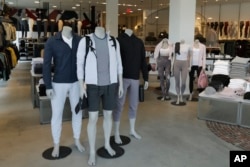Democrats exclude people who eat at Cracker Barrel, a chain of restaurants with a Southern country theme. Republicans filter out voters who shop at Whole Foods Market, a supermarket chain with a focus on natural and organic foods.
These are two examples of how political campaigns are using people’s eating, shopping and entertainment preferences in hopes of reaching the online audience that’s most receptive to their political message, according to an Axios analysis of political ad data at Meta, owner of Facebook and Instagram.
Axios says it analyzed more than 93,000 targeting inputs for paid political ads on Facebook and Instagram.
It found that Democrats were more likely to target fans of National Public Radio, a publicly and privately funded nonprofit media organization with a stated goal of creating a more informed public; Spanish-language outlets like Univision; and people with a general interest in journalism. Republicans, by contrast, were less likely to target potential voters based on their media preferences.
The GOP was more likely to zero in on fans of the reality TV show “Duck Dynasty,” about a family that makes products for duck hunters and is known for their long beards and conservative, evangelical Christian views. Republicans also targeted fans of popular country music singers and Southern celebrity chef Paula Deen. Democrats focused more on fans of singer Lady Gaga and music genres like salsa and hip hop.
In addition to Whole Foods, Republicans also nixed people who shop at Trader Joe’s, a grocery chain known for unique and eclectic offerings at reasonable prices, opting instead to target fans of Chick-fil-A, a popular fast-food restaurant whose chief executive officer has made statements opposing same-sex marriage in the past.
“We used to actually be able to get even more narrow and be able to target people by race or by partisanship, and so that has all been taken away, so these interest targets are now just a proxy for what has previously been done,” says Megan Clasen, a digital marketing consultant who worked on both Joe Biden and Hillary Clinton’s presidential campaigns.
“It has more risks when you're running a persuasion campaign. When you're making assumptions about how people's interests impact their political views, you might be leaving people out who could potentially be with you, just because they shop at certain places or watch a certain show.”
Digital marketers had to get more creative with targeting last year, after public outcry prompted Meta to stop allowing advertisers to target their ads using factors such as people’s race, sexual orientation and political or religious views.
“Facebook had tons and tons of data on what people's preferences and likes were. So, if people liked Republican pages or if they liked Democrat pages, if they liked Republican politicians, if they liked Democrat politicians, if they signed up for pro-life [anti-abortion] groups, or if they signed up for groups associated with pro-choice [pro-abortion rights], or Second Amendment [gun rights], or anti-tax groups,” says Tyler Brown, former director of digital strategy at the Republican National Committee (RNC). “So, Facebook also became a provider of what we would call third party data. And the value for advertisers was that it was extremely robust and thorough.”
Without that valuable Meta data, political operatives zeroed in on consumer preferences to reach certain parts of the electorate. While Republicans targeted people who shop at stores selling outdooring gear, Democrats focused on fans of Nordstrom, a luxury department store chain; Lululemon, a higher-end athleisure brand; and Zara, a retailer of inexpensive trendy clothes.
While the two major political parties often seem to be targeting two different Americas, there were some commonalities. For example, both targeted Walmart shoppers.
Clasen believes in casting a wider net when it comes to digital marketing.
“Oftentimes, when we're trying to persuade people, we're sort of talking to people who land in the middle — maybe they don't really identify as super liberal or super conservative,” she says. “So, I think we have to be careful about using those types of inclusions or exclusions in our targeting when we're trying to persuade broader groups of voters.”
Republicans were more likely than Democrats to focus on sports fans, including hunters and people who follow NASCAR auto racing. Democrats tended to exclude deer hunters and car racing fans from seeing their digital ads.
“They're trying to be more targeting than running blanket ads, but there is some risk that they are losing people in the gaps,” Brown says. “NASCAR has a large supporter base. It's very possible that many Democrats are supporters of NASCAR, but [digital ad consultants] are trying to make bets that, on the whole, they're targeting more of their supporters. And they're making the assumption that that is a better targeting method than simply targeting a geographic area.”
Both Brown and Clasen say this type of targeting can sow division on the internet, especially with Facebook’s algorithm already filtering posts so that people are seeing content that they're most likely to engage with.
“That obviously is already creating a lot of polarization in social media environments,” Clasen says. “So it's sort of contributing to that continued impact, if people are really only seeing things that they are likely to already agree with versus seeing different opinions that they aren't used to being exposed to.”
Politicization of commercial brands is also leading to increased polarization in American society, Brown says.
“I think that we are seeing a divide take place, culturally, in terms of, not just the media we consume, but the brands we choose to support,” Brown says. “The reason that the American democracy experiment was so successful for so long, was that while people may have different policy preferences, they operated from the same shared sense of values and worldview … And I think that as those people are separating themselves into different camps, that even those values and worlds and perspectives are coming into question and are being undercut.”







